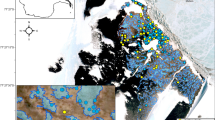Abstract
The aim of this study was to estimate the importance of factors affecting the breeding success of the grey heron (Ardea cinerea) in three colonies in the northern Poland (Mosty, Kiersity and Kąty Rybackie), differentiated in population size, habitat type and feeding areas used by birds. The highest mean number of fledglings (39–51 days old) per nest in 2000–2002 combined was recorded at Kąty Rybackie (3.2±0.91 SD). Lower values were recorded at Kiersity (2.5±1.11) and Mosty (2.8±1.20). Breeding success increased with the size of the heronry (r7=0.77, P<0.05) and was the highest in the biggest, at Kąty Rybackie (716–879 nests). In the studied colonies, the number of feeding visits was the most important factor affecting breeding success. At Kąty Rybackie and Kiersity, chick mortality significantly decreased with increasing numbers of feeding visits per nest. The highest breeding success was recorded in the colonies with feeding areas situated nearby (Kąty Rybackie and Mosty). Siblicide was also a very important reason of chick mortality in those colonies (54% and 32% chicks died in nests where sibling aggression was observed). Other factors, independent of the level of feeding, like predation, human disturbance, weather condition and experience of parent birds, seem to be of negligible importance.



Similar content being viewed by others
References
Butler RW, Whitehead PE, Breault AM, Moul IE (1995) Colony effects on fledging success of great blue herons (Ardea herodias) in British Columbia. Colon Waterbirds 18:159–165
Carlson BA, McLean BE (1996) Buffer zones and disturbance types as predictors of fledging success in great blue herons, Ardea herodias. Colon Waterbirds 19:124–127
Creutz G (1981) Der Graureiher. Ziemsen, Wittenberg-Lutherstadt
Czapulak A, Adamski A (2002) Biologia rozrodu czapli siwej Ardea cinerea gniazdującej w szuwarze trzcinowym. Not Ornithol 43:207–217
Drent RH, Draan S (1980) The prudent parent: energetic adjustments in avian breeding. Ardea 68:225–252
Frederick PC, Spalding MG (1994) Factors affecting reproductive success by wading birds (Ciconiiformes) in the Everglades. In: Davis SM, Odgen JC (eds) Everglades: the ecosystem and its restoration. St. Lucie Press, Delray Beach, Fla.
Hafner H (1997) Ecology of wading birds. Colon Waterbirds 20:115–120
Jakubas D (2003) Czynniki wpływające na ekologię rozrodu czapli siwej Ardea cinerea L. – porównanie 4 kolonii lęgowych w północnej Polsce. PhD Thesis, University of Gdańsk, Poland
Jakubas D (2004a) Sibling aggression and breeding success in the grey heron. Waterbirds 27:297–303
Jakubas D (2004b) The response of grey heron to rapid increase of the round goby. Waterbirds 27:304–307
Lowe FA (1954) The heron. Collins, London
Marion L (1989) Territorial feeding and colonial breeding are not mutually exclusive: the case of the grey heron (Ardea cinerea). J Anim Ecol 58:693–710
Martin TE (1987) Food as a limit on breeding birds: a life historyperspective. Annu Rev Ecol Syst 18:453–487
Milstein PL, Prestt I, Bell AA (1970) The breeding cycle of the grey heron. Ardea 58:171–257
Mock DW, Lamey TC, Ploger BJ (1987) Proximate and ultimate roles of food amount in regulating egret sibling aggression. Ecology 68:1760–1772
Newton I (1998) Population limitation in birds. Academic Press, London
Owen DF (1960) The nesting success of the heron Ardea cinerea in relationship to the availability of food. Proc Zool SocLond 133:597–617
Simpson K, Smith JNM, Kelsall JP (1987) Correlates and consequences of coloniality in great blue herons. Can J Zool 65:572–577
Stotskaja EE (1983) [The waders (Ciconiformes) coloniality study with special reference to Gray Heron (Ardea cinerea L.)] in: Coloniality in birds, function, evolution. Collection of papers, University of Kuibyshev, Oblastnaya Tipografia, Kuibyshev (in Russian)
Stotskaja EE (1984) [Parental behaviour and some peculiarities of the gray heron (Ardea cinerea) nesting on the Furugelm Island, Japan Sea]. Ornitologija 19:128–134 (in Russian)
Utschick, H. (1982) Nahrungsgrundlagen und Aktivitätsmuster des Graureihers (Ardea cinerea) in Bayern. Garmisch Vogelkd Bericht 10:52–72
Vessem J van (1991) Timing of egg-laying, clutch size and breeding success of the Grey Heron, Ardea cinerea, in the north of Belgium. Gerfaut 81:177–193
Vessem J van, Draulans D (1986a) Factors affecting the length of the breeding cycle and the frequency of nest attendance by grey herons Ardea cinerea. Bird Study 33:98–104
Vessem J van, Draulans D (1986b) On the adaptive significance of colonial breeding in the grey heron Ardea cinerea: inter- and intracolonial variability in breeding success. Ornis Scand 17:356–362
Vessem J van, Draulans D (1986c) Nest attendance by male and female Grey Heron. J Field Ornithol 57:34–41
Vessem J van, Draulans D (1987) Spatial distribution and time budget of radio-tagged grey herons, Ardea cinerea, during the breeding season. J Zool 213:507–534
Wojczulanis K (2003) Rola pokarmu wykrztuszonego przez kormorany Phalacrocorax carbo w diecie czapli siwej Ardea cinerea w koloni mieszanej w Kątach Rybackich. MSc Thesis, University of Gdańsk, Poland
Zar JH (1996) Biostatistical analysis. Prentice-Hall, Upper Saddle River, N.J.
Acknowledgments
I would like to thank Prof. L. Stempniewicz for critical comments on the first version of the manuscript. This project was supported by grants of the State Committee for Scientific Researches (6 PO4G 030 18) and University of Gdańsk (BW 1140–5-005–0).
Author information
Authors and Affiliations
Corresponding author
Additional information
Communicated by F. Bairlein
About this article
Cite this article
Jakubas, D. Factors affecting the breeding success of the grey heron (Ardea cinerea) in northern Poland. J Ornithol 146, 27–33 (2005). https://doi.org/10.1007/s10336-004-0051-8
Received:
Revised:
Accepted:
Published:
Issue Date:
DOI: https://doi.org/10.1007/s10336-004-0051-8




